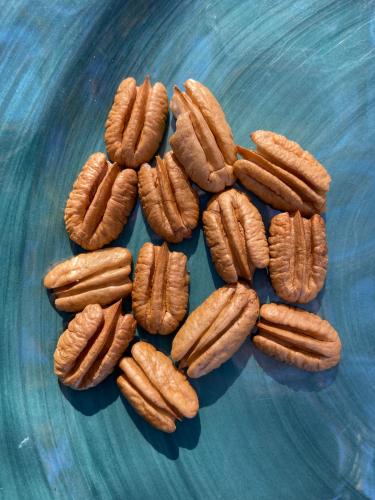The boat ramp closes when the river reads 33' on the Cape Girardeau river gauge. The boat ramp is not usable when the Mississippi River is at or below 8' on the Cape Girardeau river gauge.

The pecan is a large tree with a narrow, pyramid-shaped crown in the forest, and a broad and rounded crown in the open. It is the largest of all the hickory trees.
Leaves are alternate, compound, 9–20 inches long, with 9–17 leaflets; leaflets 4–8 inches long, 1–3 inches wide, lance-shaped, curved; margins toothed; upper surface dark green; lower surface paler, smooth to hairy.
Bark is grayish brown to light brown when young, becoming dark reddish brown with age; ridges long, flat, loose.
Twigs stout, reddish brown, hairy, with numerous elongated orange-brown pores; bud on end of twig yellow-brown.
Flowers April–May, male catkins and female clusters separate on the same tree.
Fruits September–October, in clusters of 3–10; husk thin, aromatic, reddish brown, winged, splitting along 4 ridges at maturity to expose the nut. Nut thin, 1–3 inches long, 2–4 times longer than broad, cylindrical, pointed at the tip, light brown to reddish brown, with irregular black markings on the shell; kernel sweet and edible.
Height: to 130 feet.

Statewide except for northwestern counties.
Habitat and Conservation
Occurs naturally in rich, moist bottomland soils; widely planted elsewhere. Commonly associated in the wild with green ash, sycamore, pin oak, sweet gum, and cottonwood. Typically a southern species, pecan once grew only in the southeastern part of the state. It is thought that Native Americans cultivated this tree farther north and helped spread it. Pecans with large, thin-shelled nuts are grown in commercial orchards.
Status
The name "pecan" has an interesting history. It started as an Illinois (Native American) word, "pakani," which early French-Americans learned and turned into "pacane" (try saying that with a Creole accent); this became our American English "pecan." But even then, pronunciations vary by region. New Englanders and many people along the Atlantic coast tend to say "PEE-can"; Louisianans, Texans, Oklahomans, Mississippians, and many Missourians say "pih-KAHN"; people in Wisconsin, Minnesota, and upper Michigan say "PEE-kahn"; and most other Americans say "pee-KAHN." Each pronunciation is correct, depending on the dialect you learned.
Human Connections
Pecan has been cultivated since 1766. More than 500 horticultural selections have been made to improve hardiness, productivity, and the nuts’ size, flavor, and ease of shelling. It is one of the most important cultivated nuts of North America. The wood is used occasionally for furniture, flooring, tools, and more.
Recipes abound for pecan nuts. In addition to eating them out of hand or in cookies, candies, muffins, pancakes, and quick breads, you can use them in pesto, in a coating for fried fish or chicken, in a wild mushroom pâté, in poultry stuffing, and in (or on) ice cream. (Okay, now you're drooling!)
Ecosystem Connections
The nuts are eaten by a variety of wildlife — larger birds, squirrels and other small rodents, opossums, raccoons, and deer. The trees also provide cover and denning areas for wildlife.
Like other members of the hickory/walnut family, pecan trees are the host for several moths and other insects whose larvae eat the foliage. Among the moths are several species of underwings, the luna moth, fall webworms, tussock moths, tortricids, and more, including the regal moth, whose spectacular caterpillar, the hickory horned devil, can grow as big as a hot dog. All these caterpillars make protein-rich meals for birds and other predators.

















































